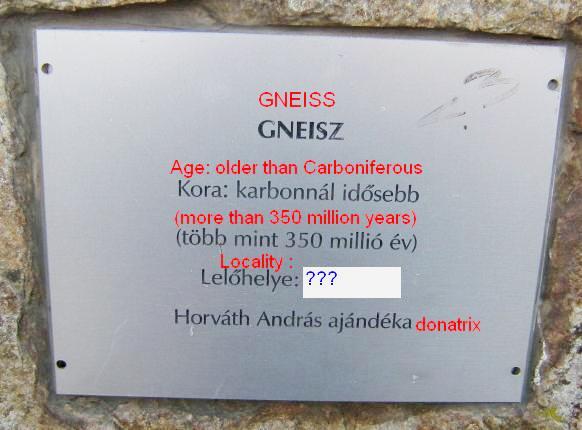Gneiss and Others EarthCache
-
Difficulty:
-

-
Terrain:
-

Size:  (other)
(other)
Please note Use of geocaching.com services is subject to the terms and conditions
in our disclaimer.
The huge rocks placed near the Hungarian Natural History Museum entrance tell about millions of years of the geological history. Exhibited in the order of their formation, they include a Gneiss, a Devonian limestone rock from Szabadbattyán, a Permian sandstone from the Balaton Highlands. The Mesozoic is represented by sedimentary rocks (limestone with molluscs and ammonites). The last 65 million years produced rocks formed in volcanic, marine, and fresh water environment.
Gneiss is common and widely distributed type of rock formed by high-grade regional metamorphic processes from pre-existing formations that were originally either igneous or sedimentary rocks. Gneissic rocks are usually medium to coarse foliated and largely recrystallized but do not carry large quantities of micas, chlorite or other platy minerals. Gneisses that are metamorphosed igneous rocks or their equivalent are termed granite gneisses, diorite gneisses, etc. However, depending on their composition, they may also be called garnet gneiss, biotite gneiss, albite gneiss, etc. Orthogneiss designates a gneiss derived from an igneous rock, and paragneiss is one from a sedimentary rock. Gneissose is used to describe rocks with properties similar to gneiss.
Gneiss resembles schist, except that the minerals are arranged into bands. Sometimes it is difficult to tell the difference between gneiss and a schist because some gneiss appears to have more mica than it really does. This is especially true with mica-rich parting planes.

To log yor visit, please.
Send your answers via e-mail to me...
Please don’t give answers in your log !
1, Locality from which the rock gneiss (GNEISZ)?
2, One of the rock in a famous cartoon family name can be found, what is it ?
3, The color of the marble block (MÁRVÁNY) ?
If you want you can upload a photo with you and/or your GPS from the header coordinates, or one rock in the background.
-----------------------------------------------------------------------
A Magyar Természettudományi Múzeum épülete mellett elhelyezett több tonnás kozettömbök a földtörténeti múlt több száz millió évérol vallanak. A keletkezésük sorrendjében kiállított kozetek között van egy darab gneisz, egy devon korú mészkoszikla Szabadbattyánból, egy perm homokkotömb a Balaton-felvidékrol. A földtörténeti középkort üledékes kozetek (kagylós és ammoniteszes mészko) képviselik. Az utolsó hatvanöt millió évben keletkezett kozetek között vulkáni képzodményeket, tengeri és édesvízi környezetben keletkezett kozeteket egyaránt találunk.
A gneisz kovasavakban gazdag metamorf kozet, melynek földpáttartalma több mint 20 % és világosabb-sötétebb rétegek váltakozásából áll. Nagyfokú metamorfózis során igen magas homérsékleti tartományban képzodik, ezért egyes ásványok újrakristályosodása révén a gneiszre jellemzo porfiroblasztos szövet fejlodik ki. Bár a kozet színe általában rózsaszín vagy szürke, az összetételtol függoen sok színváltozata fordul elo. Réteges szerkezetu, a rétegek pedig gyakran eltéro színuek és néha hullámos, lemezes mintázatot mutatnak az egy irányba rendezodött biotitszemcséknek köszönhetoen. A kozet képzodhet üledékes és magmás kozetbol egyaránt.
A logoláshoz kérlek…
Küldd el a válaszokat számomra e-mailben...
Kérlek, ne adj meg választ a logban !
1, A helység, ahonnan a gneisz szikla származik ?
2, Az egyik kövön egy híres képregény-család neve olvasható, mi ez ?
3, A márványtömb színe ?
Ha van kedved tölts fel fotót magadról és/vagy a GPS-edrol, a megadott koordinátákon, vagy egy sziklával a háttérben.

Additional Hints
(No hints available.)